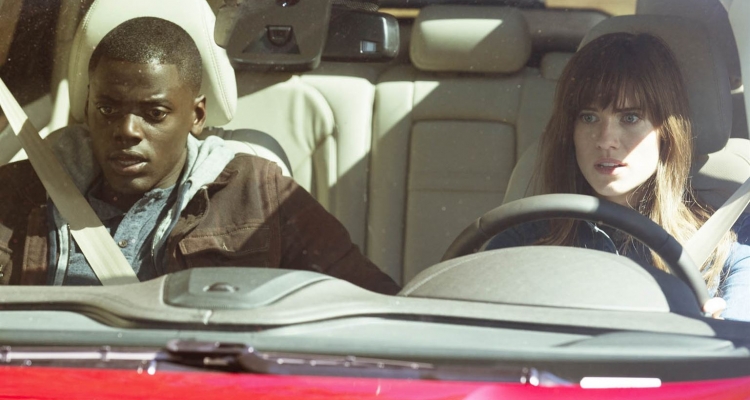4. “Columbus” (Kogonada)
Jin (John Cho), a Korean-born man arrives in Columbus, Indiana, one of the great, but relatively-unknown-to-the-laymen architectural cities in the world, where his legendary architect father is in a coma. He meets Casey (Haley Lu Richardson) a young enthusiast of his father’s, who wishes to pursue her dreams outside of the small city but is burdened to take care of her recovering addict mother. The bond these two lost souls create in this magical city of Architectural heaven is not just touching but has a surreal aspect to it that makes the viewer feel as if they just got lost in a dream. Columbus, Indiana’s famous modern architecture is featured prominently throughout as Casey guides Jin to her favorite spots. Their corresponding conversations, filled with cigarette smoke, gradually become more detailed and more revealing. Director Kogonada, in his impressive debut, conveys emotion through site and sound. He turns out to be a master of not just visual setting, but of conversational filmmaking, and his “Columbus” might just be a masterpiece.
 3. “The Florida Project” (Sean Baker)
3. “The Florida Project” (Sean Baker)
After “Tangerine,” Sean Baker sets up his camera again with an eye towards uncharted America with “The Florida Project.” This time his eye goes towards the makeshift motels that litter the main avenues towards Disneyland, distilling a moist, colorful, and shimmering atmosphere, thanks to Alexis Zabe‘s beautiful photography. Moonee (Brooklynn Prince) is 6 years old and lives in a motel with her mother Halley (Bria Vinaite). On summer break, Mooney and her ragtag group of friends look for adventure as they roam through the outskirts of the motel while the adults around them struggle to make ends meet. Baker shoots his own “400 Blows” with his little band of insolent misfits. The atmosphere, paradoxically decadent and disenchanted, mixes what filmmaker himself calls “pop verité” cinema, to create a hybrid of hope and misery that feels both transcendent and groundbreaking. Like “Tangerine,” it is this sense of freedom, freshness and energy that, in Baker’s mise-en-scene, from the camera to the non-professional actors, the film maps contemporary America. Baker doesn’t succumb to the sirens of miserabilism, even though the final, sad frame might hint at this. Instead, he prefers the fanciful fantasy of the children who, in their flight forward, give themselves moments of happiness by the simple light of a blue sky.
2. “Call Me By Your Name” (Luca Guadagnino)
The romance between a seventeen-year-old Italian boy named Elio (Timothée Chalamet), and an American summer guest, Oliver (Armie Hammer), staying at his parents’ cliffside mansion in southern Italy. “Call Me By Your Name” is a film that is simply told, but packs a wallop by the end of its 130 minute running time. The film is filled with intense emotions as director Luca Guadagnino lingers on the sheen of sweat that shimmers in a southern Italian summer filled with first love. Armie Hammer’s performance is a career-peak and merits every award destined to come his way this season. Ditto newcomer Chalamet who might just win the Oscar. The chemistry between these two actors is electrifyingly real. This is an erotic and mesmerizing movie that exemplifies cinematic artistry in scope, theme, and tone. A late-film monologue by Michael Stuhlbarg is a particular highlight and brings it all together beautifully. Guadagnino is a master at eliciting senses, and the audience’s sense of senses are used to full effect to simulate the true feelings of being in Italy. From luscious depictions of peaches and apricots grown in the countryside, to the streets in gorgeous Italian towns and the steamy espresso, every sight and sound in the film feels truly authentic and impactful on the viewer. I have not seen such an effective use of reflecting on audiences’ senses to create a more immersive viewing experience in a film in years. I wanted to immediately go to Italy and … feel.
 1. “Get Out” (Jordan Peele)
1. “Get Out” (Jordan Peele)
Chris Washington, a young African-American male (Daniel Kaluuya) is about to meet the parents of his white girlfriend Rose (Allison Williams) for a weekend in their posh, but the secluded cottage. The old adage of trust none of what you heard and even less of what you see is put to full-throttle here. Don’t expect “Guess Who’s Coming to Dinner” speechifying, at least not in the hands of first-time director Jordan Peele, one-half of the comedic duo Key and Peele, who has the time of his life messing with our heads his horror-satire “Get Out.” The clever film packed plenty of tension was the most fun I had in a movie theater all year, but it also found a way to skewer and make critical insights about the race relations in America. “Get Out” wasn’t just a horror comedy, but it was filled with political fireworks that made it a lot more nuanced and thought-provoking than your average B-movie flick. The film was refreshingly incisive for its stab at the white liberal and conservative elite. Something you don’t see much in the media or at the movies these days. Peele was smart enough to skewer all of white America and demand they wake up to the elephant in the room. Hypocrisy seems to be the name of the game and “Get Out” was the most relevant movie of the year.
I could have easily made this a top 20. Know what? Here are ten other titles that shouldn’t be neglected: Olivier Assayas‘ “Personal Shopper,” David Lowery‘s “A Ghost Story,” S. Craig Zahler‘s “Brawl in Cellblock 99,” Joshua Z Weinstein‘s “Menashe,” Martin Mcdonagh‘s “Three Billboards Outside Ebbing Missouri,” Edgar Wright‘s “Baby Driver,” Martin Spicer‘s “Ingrid Goes West,” Matt Reeves‘ “War for the Planet of the Apes,” Bryan Fogels‘ “Icarus,” and Michael Haneke‘s “Happy End.“

